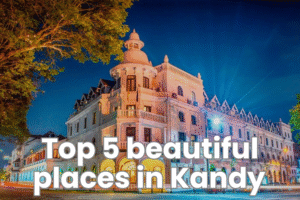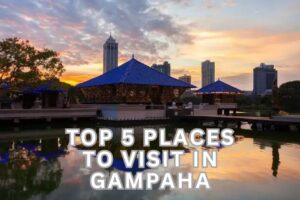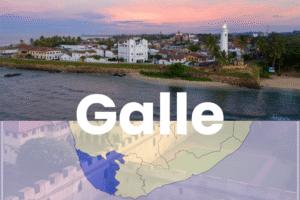Introduction
Nestled in the picturesque hills of central Sri Lanka, Kandy District stands as a testament to the rich cultural heritage and natural beauty of the island nation. As the last capital of the ancient kings of Sri Lanka, Kandy holds a special place in the hearts of locals and continues to captivate travelers from around the world. This UNESCO World Heritage Site combines historical significance with breathtaking landscapes, making it an essential destination for anyone visiting Sri Lanka.
Located about 115 kilometers from Colombo, Kandy sits at an elevation of 500 meters above sea level, providing a cooler climate than the coastal regions and creating a refreshing retreat from the tropical heat. The district is renowned for its sacred Buddhist sites, colonial architecture, traditional arts and crafts, and stunning natural scenery.
In this comprehensive guide, we’ll explore the top five tourist attractions in Kandy District that showcase the area’s unique blend of cultural importance and natural splendor. Whether you’re planning a spiritual journey, seeking historical insights, or simply want to immerse yourself in the beauty of Sri Lanka’s central highlands, these destinations promise an unforgettable experience that will leave you with lasting memories of this magnificent region.
1. Temple of the Sacred Tooth Relic (Sri Dalada Maligawa)

Historical Significance
The Temple of the Sacred Tooth Relic, locally known as Sri Dalada Maligawa, stands as the crown jewel of Kandy’s cultural landscape. This revered Buddhist temple houses Sri Lanka’s most important Buddhist relic—a tooth of the Buddha himself. According to historical accounts, the tooth was brought to Sri Lanka in the 4th century CE, hidden in the hair of a princess from the ancient kingdom of Kalinga (modern-day Odisha, India).
The temple’s significance extends beyond its religious importance. Throughout history, it has played a crucial political role as well. It was believed that whoever held custody of the sacred tooth relic had the divine right to rule the land, making it a symbol of sovereignty and political legitimacy in ancient Sri Lanka.
Architectural Marvels
The temple complex showcases the exquisite Kandyan architectural style, characterized by its white outer walls with a golden roof. The main shrine is adorned with intricate wood carvings, ivory inlays, and lacquer work, demonstrating the exceptional craftsmanship of local artisans. The complex includes several buildings, including the New Palace (Maha Maluwa), the Old Palace (Palle Vahala), and various museums and gardens.
Visitors will be captivated by the detailed decorations, particularly the decorative moonstones at entrances, elaborately carved pillars, and painted wooden panels depicting various Buddhist stories and local legends. The temple also houses an impressive collection of Buddha statues and ancient manuscripts.
Visitor Experience
The temple welcomes visitors daily, though it’s important to note that the sacred tooth relic itself is rarely displayed to the public. Instead, it resides within seven golden caskets, nested within each other like Russian dolls. Devotees and tourists can, however, participate in the daily ritual ceremonies (puja) held at dawn, midday, and evening, when the room housing the relic is opened to worshippers.
When visiting, remember to dress modestly with shoulders and knees covered as a sign of respect. The best time to visit is during the Esala Perahera festival (usually held in July or August), an ancient celebration featuring elaborately decorated elephants, traditional dancers, and drummers in a magnificent procession honoring the sacred tooth relic.
2. Royal Botanical Gardens, Peradeniya

Historical Development
Located just a few kilometers from the city center, the Royal Botanical Gardens in Peradeniya ranks among the most impressive botanical gardens in Asia. Originally established in 1371 as a royal pleasure garden, it was transformed into a botanical garden during the British colonial period in 1821. The gardens have evolved over two centuries into a world-class collection of tropical flora spread across 147 acres (60 hectares) of meticulously landscaped grounds.
The gardens have played a significant role in the introduction and development of various economic crops in Sri Lanka, including rubber, tea, nutmeg, and cinchona (used for quinine production). Today, they function as both a recreational space and an important research center for botanical studies.
Botanical Diversity
The Peradeniya Gardens boast an impressive collection of over 4,000 plant species, including rare and endemic flora. The garden is divided into different sections, each showcasing specific plant families or geographic origins. Notable collections include:
- The orchid house, containing over 300 varieties of exquisite orchids
- The palm avenue, featuring towering royal palms planted in 1905
- The giant Javan fig tree with its massive aerial roots covering 1,800 square meters
- The spice garden, where visitors can learn about Sri Lanka’s famous spices
- A memorial tree plantation where world leaders and dignitaries have planted trees
The gardens also feature a herbarium, a botanical library, and various themed gardens including a medicinal plants garden and a Japanese garden. The giant bamboo collection, with culms reaching up to 30 meters high, never fails to impress visitors.
Visitor Experience
The Royal Botanical Gardens offer a peaceful retreat from the bustling city life. Visitors can spend hours wandering along shaded pathways, enjoying picnics on the expansive lawns, or simply sitting beside the Mahaweli River that borders the gardens. The cool climate makes it pleasant to explore even during midday.
Guided tours are available and highly recommended for those interested in learning more about the botanical significance of the collections. The gardens are particularly beautiful during the blooming seasons of various tropical flowers, especially from December to April. For photography enthusiasts, the early morning hours provide the best lighting conditions and fewer crowds.
3. Kandy Lake (Kiri Muhuda)

Historical Creation
Kandy Lake, also known as Kiri Muhuda (the Sea of Milk), is an artificial lake created in 1807 by the last king of Kandy, Sri Wickrama Rajasinghe. This magnificent body of water sits at the heart of Kandy city, providing a serene centerpiece to the bustling urban environment. According to local legends, the king used this area, previously a paddy field, to create the lake as part of his grand plan to enhance the beauty of his capital city.
The construction was no small feat for its time. The king had a dam built across the valley and used forced labor to excavate and shape the lake. Historical records suggest that the project was not without controversy, as the heavy labor demands on the local population contributed to the unpopularity of the king’s later rule.
Scenic Beauty
Today, Kandy Lake covers approximately 19 hectares and is surrounded by a decorative white parapet wall known as the “Walakulu wall.” The lake creates a picture-perfect setting with the Temple of the Sacred Tooth Relic and the surrounding hills reflected in its calm waters. The small island in the middle of the lake, originally used as the king’s personal bathing pavilion, adds to its picturesque charm.
The walkway around the lake extends for about 3.5 kilometers, offering changing perspectives of the cityscape and the surrounding mountains. The area is particularly enchanting at sunset when the fading light casts golden hues across the water and illuminates the white temple buildings.
Visitor Experience
Taking a leisurely stroll around Kandy Lake is one of the most popular activities for both tourists and locals. The path is well-maintained and offers numerous benches for resting and enjoying the views. Bird watchers will be delighted by the variety of water birds that inhabit the lake, including cormorants, pelicans, and various duck species.
The small vendors along the pathway offer traditional snacks and refreshments, allowing visitors to enjoy local flavors while taking in the scenery. For the best experience, visit early in the morning when the mist often hovers over the water, creating a mystical atmosphere, or in the evening when the surrounding lights reflect on the lake’s surface.
4. Udawattakele Forest Reserve

Historical Significance
Just behind the Temple of the Sacred Tooth Relic lies the Udawattakele Forest Reserve, a historic sanctuary that once served as the king’s private garden and hunting grounds. The name “Udawattakele” translates to “Garden above the royal palace.” Following the British conquest of Kandy in 1815, the forest was designated as a reserve, protecting it from development and preserving its ecological significance.
Historical records indicate that the forest contained various structures during the Kandyan period, including hermitages for Buddhist monks and meditation spaces for the king. Some of these ancient sites can still be discovered hidden among the dense vegetation, providing glimpses into the area’s rich past.
Ecological Diversity
Despite its relatively small size of 104 hectares, Udawattakele is a biodiversity hotspot containing an impressive variety of flora and fauna. The forest is classified as a tropical rainforest and serves as a vital ecological buffer zone for Kandy city, influencing the local climate and water resources.
The reserve is home to over 460 plant species, including numerous medicinal plants used in traditional Ayurvedic medicine. Wildlife enthusiasts can spot various mammals including toque macaques, purple-faced leaf monkeys, barking deer, and wild boar. Birdwatchers are particularly drawn to Udawattakele, with over 80 bird species recorded in the reserve, including endemic species like the Sri Lanka hanging parrot and the yellow-fronted barbet.
Visitor Experience
Well-marked trails crisscross the forest, making it accessible to visitors of varying fitness levels. The main pathway forms a loop of approximately 5 kilometers, taking visitors through different forest zones and past several points of interest. Notable attractions within the reserve include:
- The Lady Horton’s Walk, offering panoramic views of Kandy city
- Ancient forest hermitages where monks still occasionally meditate
- The “Coding Tree,” where the Kandyan kings reportedly held court
- Several small ponds that attract wildlife, especially during dry seasons
For the best wildlife viewing opportunities, visit early in the morning when animals are most active. Guided tours are available and recommended for first-time visitors who want to learn about the ecological and historical significance of specific areas within the reserve. Remember to bring insect repellent, water, and wear comfortable walking shoes.
5. Embekka Devalaya (Temple)

Historical Origins
Located about 12 kilometers from Kandy city in the village of Embekka, the Embekka Devalaya stands as a testament to the exceptional woodcarving craftsmanship of the Kandyan era. Constructed in the 14th century during the reign of King Wickramabahu III (1357-1374), the temple is dedicated to Kataragama Deviyo (a guardian deity of Sri Lanka) and exemplifies the unique architectural style of the period.
According to local legends, the temple was built following a dream vision received by the king. The site quickly became an important religious center, attracting pilgrims from across the kingdom. What makes Embekka particularly special is that it survived numerous foreign invasions and natural disasters that destroyed many other wooden structures from the same period.
Architectural Marvels
The Embekka Devalaya consists of three main sections: the Sanctum of Garagha, the Dancing Hall, and the Drummers’ Hall. While the entire complex showcases remarkable craftsmanship, it’s the wooden pillars and ceiling of the Drummers’ Hall that have earned international acclaim. These intricately carved wooden structures feature over 125 unique designs, including intertwined swans, wrestlers, soldiers, lotus flowers, and mythical beasts.
The most famous architectural element is the set of wooden pillars, each carved from a single piece of timber and decorated with elaborate motifs. Art historians consider these to be among the finest examples of wood carving anywhere in the world. The temple also features a unique roof design with no nails used in its construction—the entire wooden structure is held together through an ingenious interlocking system.
Visitor Experience
The Embekka Devalaya offers visitors a glimpse into Sri Lanka’s artistic heritage that differs from the Buddhist temples that dominate the cultural landscape. The relative quietness of this site compared to more famous attractions allows for a more contemplative experience, where visitors can take their time examining the intricate details of the carvings.
The temple remains an active place of worship, and visitors might encounter local devotees performing traditional rituals. An annual festival called the Embekka Devalaya Perahera takes place in July or August (depending on the local calendar), featuring traditional dancers, drummers, and ceremonial elephants.
When visiting, it’s advisable to engage a knowledgeable guide who can point out and explain the significance of specific carvings and motifs that might otherwise be overlooked. The site is open daily, with mid-morning visits recommended for the best lighting to appreciate the wooden carvings.
Practical Information for Visitors
Best Time to Visit
The climate in Kandy is generally pleasant throughout the year, with temperatures ranging from 18-30°C (64-86°F). However, the region experiences two monsoon seasons:
- Southwest monsoon (May to September): Brings heavy rainfall, particularly in June and July
- Northeast monsoon (December to February): Brings lighter, more intermittent rainfall
The ideal time to visit Kandy is during the inter-monsoon periods of March to April and September to November when rainfall is less frequent and temperatures are comfortable. If you’re interested in witnessing the famous Esala Perahera festival, plan your visit for July or August (exact dates vary according to the lunar calendar).
Transportation Options
Reaching Kandy from Colombo is relatively straightforward:
- By train: The scenic train journey takes approximately 2.5-3 hours and is considered one of the most beautiful rail routes in Sri Lanka
- By bus: Regular services run between Colombo and Kandy, taking 3-4 hours depending on traffic
- By car: Private taxis or rental cars provide the most flexibility, with the journey taking about 3 hours via the expressway
Within Kandy, transportation options include:
- Tuk-tuks: Convenient for short distances, though always agree on a price before starting your journey
- Local buses: Inexpensive but often crowded
- Taxis: More comfortable for longer distances
- Walking: The city center is compact enough to explore on foot
Accommodation
Kandy offers accommodation options to suit all budgets:
- Luxury hotels: Several international chains and boutique hotels offer high-end amenities with stunning views of the lake or surrounding mountains
- Mid-range options: Numerous guest houses and smaller hotels provide comfortable accommodations at reasonable prices
- Budget stays: Hostels and homestays cater to travelers on tighter budgets
For the best experience, consider staying near Kandy Lake, which puts you within walking distance of many attractions while providing scenic views.
Conclusion
Kandy District represents the cultural heart of Sri Lanka, where ancient traditions blend seamlessly with natural beauty to create an unforgettable destination. From the spiritual significance of the Temple of the Sacred Tooth Relic to the botanical wonders of Peradeniya Gardens, from the tranquility of Kandy Lake to the ecological richness of Udawattakele Forest, and finally to the artistic heritage displayed at Embekka Devalaya—these top five attractions offer a comprehensive introduction to the region’s diverse appeal.
Visitors to Kandy will find themselves immersed in a living cultural landscape where centuries-old traditions continue to thrive alongside modern developments. The district’s UNESCO World Heritage status recognizes not just its historical monuments but also the continuing cultural practices that make this region uniquely special.
Whether you’re seeking spiritual enlightenment, historical insights, natural beauty, or artistic inspiration, Kandy District delivers an authentic Sri Lankan experience that will stay with you long after your journey ends. As you explore these five remarkable attractions, you’ll discover why Kandy remains a cherished destination for travelers from around the world and a source of immense pride for the people of Sri Lanka.



